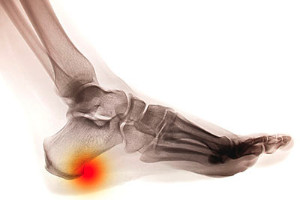
A heel spur is a bony growth on the calcaneus, or heel bone, that often extends into the arch of the foot. Though this can become painful, many people have heel spurs and are unaware of them. Heel spurs are often associated with plantar fasciitis, which is the inflammation of the band of tissue that connects the heel to the ball of the foot. Heel spurs, which are calcium deposits, develop over a period of time. They can be the result of continual stretching of the plantar fascia or repeated tearing of the membrane that covers the heel bone. Heel spurs are especially common among runners and other athletes who do a lot of jumping. Other risk factors are running on hard surfaces, footwear that does not provide proper heel cushioning or arch support, and excess weight or obesity. In addition, people who spend a great part of the day on their feet may be more likely to develop heel spurs. Seniors, people with diabetes, and anyone with arch problems also may be more at risk. If heel spurs are causing pain and interfering with your daily activities, it is suggested that you consult a podiatrist for an exam and treatment options.
Heel spurs can be incredibly painful and sometimes may make you unable to participate in physical activities. To get medical care for your heel spurs, contact Emmanuel Bustos, DPM from New York. Our doctor will do everything possible to treat your condition.
Heels Spurs
Heel spurs are formed by calcium deposits on the back of the foot where the heel is. This can also be caused by small fragments of bone breaking off one section of the foot, attaching onto the back of the foot. Heel spurs can also be bone growth on the back of the foot and may grow in the direction of the arch of the foot.
Older individuals usually suffer from heel spurs and pain sometimes intensifies with age. One of the main condition's spurs are related to is plantar fasciitis.
Pain
The pain associated with spurs is often because of weight placed on the feet. When someone is walking, their entire weight is concentrated on the feet. Bone spurs then have the tendency to affect other bones and tissues around the foot. As the pain continues, the feet will become tender and sensitive over time.
Treatments
There are many ways to treat heel spurs. If one is suffering from heel spurs in conjunction with pain, there are several methods for healing. Medication, surgery, and herbal care are some options.
If you have any questions feel free to contact our office located in New York, NY . We offer the latest in diagnostic and treatment technology to meet your needs.